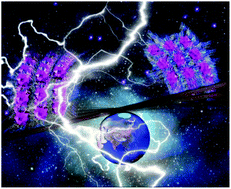Mo-Based crystal POMOFs with a high electrochemical capacitor performance†
Abstract
Mo-Based crystalline polyoxometalate-based metal–organic frameworks (POMOFs), namely, [CuIH2(C12H12N6)(PMo12O40)]·[(C6H15N)(H2O)2] (1) and [CuII2(C12H12N6)4(PMoVI9MoV3O39)] (2) (C12H12N6, 1,4-bis(triazol-1-ylmethyl) benzene, abbreviation btx) as promising capacitor electrode materials were synthesized by a hydrothermal reaction. Compound 1 consisted of two-dimensional (2D) lattice structures with free triethylamine (abbreviation, TEA) molecules and H2O molecules, and compound 2 showed a 3D host–guest structure, in which 1D polyoxometalate (POM) chains were encapsulated into a 3D Cu(II)-btx metal–organic framework (MOF). The compound 1-based electrode showed much higher specific capacitance (249.0 F g−1 at 3 A g−1) than the 2-based one (154.5 F g−1 at 3 A g−1). Moreover, the specific capacitance of the 1-based electrode was not only higher than those of the majority of the reported POMOF materials as supercapacitors, but also higher than those of most state-of-the-art MOF-based and POM-based supercapacitor electrode materials. This superior capacitance performance of the 1-based electrode could be attributed to the high redox capacity and excellent electronic conductivity. More importantly, this work may open a new avenue for optimizing the performance of POMOF-based capacitor electrode materials.



 Please wait while we load your content...
Please wait while we load your content...